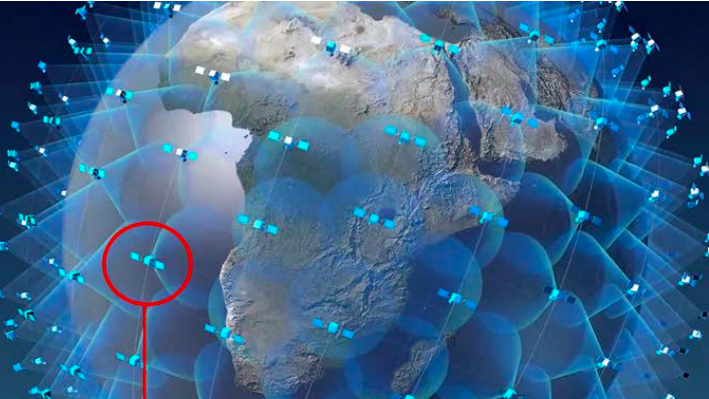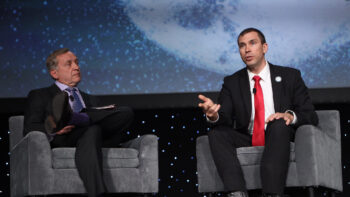
Commercial companies, governments and militaries around the globe are planning new mega-constellations of thousands of satellites in low Earth orbit, creating dangers for safe operations. (NASIC image)
SATELLITE 2023 — The White House National Space Council is still “deliberating” how to parcel out responsibilities among US regulatory agencies for oversight of new types of on-orbit activities, according to a senior official.
Many of these emerging capabilities, such as on-orbit servicing of satellites and rapid maneuver, are being eyed by the Defense Department as it seeks innovative ways to bolster military space operations.
“We had three public listening sessions, that we noticed in the Federal Register, and something like 535 of you not just registered, but actually showed up,” Diane Howard, the head of the commercial operations for the council, said on March 15. “We had 61 public comments that represented a variety of stakeholders from industry, to academia, consortia, companies, NGOs, professional organizations, even international. We also got 43 written statements.”
The National Space Council interagency group working on novel space activities has “taken in all of that information,” she told a panel on the subject at the Satellite 2023 conference in Washington. “Where are we now? We’re deliberating.”
Howard, who moderated the panel, noted that the decisions were “extremely complex,” and that the panel thus was “not going to solve any problems.” She also gave a sidewise nod to the fact that the key agencies involved are not yet all in agreement about what their respective roles and missions might be — cautioning “no smack-downs,” and stressing that the forum was “not an interagency discussion.”
At the moment there are three US government agencies with legal authorities to regulate commercial space activities using licensing procedures for companies. The Commerce Department, via the National Oceanic and Atmospheric Administration, regulates US commercial remote sensing companies. The Federal Aviation Administration (FAA), which falls underneath the Department of Transportation, regulates launch and re-entry of space vehicles with a close eye to safety. The independent (i.e., reports only to Congress, not the White House) Federal Communications Commission (FCC) governs how telecommunications companies, including satellite operators, can make use of the radio frequency spectrum.
One of the key questions that has yet to be answered — and one that divides the commercial space industry — is what is the balance between allowing the market to drive standards and practices, and understanding when the government needs to step in and regulate, according to panel participants.
“I think if we can imagine this wild world of technology that’s going to exist 10 years 20 years from now, together we need to start reimagining what regulation looks like and what that boundary between the government and the commercial sector is going to be in the future,” said Richard DalBello, director of Commerce’s Office of Commercial Space.
Randy Repcheck, of the FAA’s Office of Commercial Space Transportation, said that the very fact that the White House effort is designed to address “novel” space activities presents a challenge for figuring out regulations.
“So, we can lay out the regulations or a process to have us look at things, but we can’t be perfectly clear what’s the requirement,” he said.
That said, Repcheck argued that if commercial industry could come up with its own safety and operational standards first, it would make the government’s job easier.
“The more industry can do to develop voluntary consensus standards .. the better off the government is,” he said.
And while many of the companies working in what is often called “New Space” are adamant that it is too soon for regulations, worried about constraints that might harm their often precarious bottom lines, there also are a number of industry voices pleading for new regulations to a) create certainty for operators in planning future ventures, and b) ensuring against unsafe operations that could imperil all space actors.
Tory Bruno, CEO of United Launch Alliance, was especially blunt on the problems already being caused by the advent of mega-constellations of thousands of low Earth orbit satellites in an environment where operators have few restrictions. In particular, he voiced strong concern about constellations companies that fail to share information on the whereabouts of their satellites, those that are allowing dead satellites to become space junk in orbit creating collision hazards for active birds, and those that are allowing spacecraft to simply fall out of orbit in an uncontrolled manner.
“These are very dense shells that exist in LEO, where there’s much less volume of space to work with. And so a mega-constellation presents an access to space challenge in a common environment that we all share. So we very, very much need standards. This has actually gotten a little bit away from us already,” Bruno said.
He stressed that this means that “licensing has to consider the physical density of a constellation that’s never been necessary before.” It also means that the US has to work hard to broker international agreements, citing China’s plans to put 30,000 satellites into LEO.
“And as weird as that sounds, you know, from an industry guy, I absolutely need regulation and enforcement,” Bruno said. “Because one bad actor can ruin that entire common environment for all of us.”






















